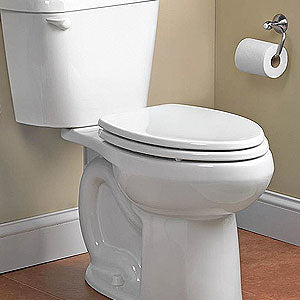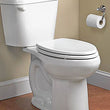Toilet Tips & Terms
Whether you are adding a new bathroom to your home or remodeling an existing one, chances are you will be planning on buying a new toilet. Knowing the right terminology gives you a common language and a starting place for selecting the right toilet when planning and discussing your project. Before you shop, it’s beneficial to know some common term relating to toilet styles, types, and models to help save you time and money. Here, you’ll find helpful terms and tips regarding toilet selection for planning and discussing your project.

Tips to Consider
Avoid disappointment and added cost by planning in advance
When designing a new bathroom, homeowners often wait until their rough plumbing is installed behind the wall to actually shop for a new toilet. Some options, such as wall-hung toilets, require plumbing to be done differently. In the case of a replacement toilet, the plumbing will already be in place. It’s important to share what stage your project with a bathroom remodeling specialist or professional contractor so you select from options that are appropriate for your situation. If you are committed to a particular style, check with a professional before the plumbing is done.
Consider your priorities
Is the style and look of a new toilet your top priority, or do you want to make sure you select a self-cleaning model? Is water conservation a high priority for you? Are you interested in the health benefits of a bidet toilet or washlet seat? Don't hesitate to ask questions to help guide you to options that address your top priorities.
Comfort Height
Comfort Height or Right Height toilets feature a taller rim, measuring 17” high. Taller people find this a more “comfortable” height. Elderly persons or those with mobility problems may also find this style toilet to be preferred. The height of a toilet is a very personal decision, as children or shorter family members may find it more challenging to use a taller toilet.
Gallons Per Flush (GPF)
The amount of water used per flush. The current maximum allowed by law is 1.6 GPF, though newer models use as little as 1.0 gallons per flush.
High-Efficiency Toilet (HET)
High-efficiency toilets are perfect for those who are focused primarily on water conservation. Most HETs use 1.28 gallons per flush, however, a few use even less. It is important to think about water savings and performance to assure you get the model that’s right for you.
Flushing Type
There are two flushing types: single flush and dual flush. A single-flush toilet, the standard flushing system, uses the same amount of water for each flush. A dual-flush toilet provides two choices: a “half-flush” for liquids and a full flush for solids. There are typically two buttons or levers to operate the dual flush or a single level that operates in two directions (up or down).
Hands-Free Flushing
When your hand passes by a motion sensor on a hands-free toilet, it automatically flushes, eliminating the need to touch the toilet to engage the flushing mechanism.

Terms to Understand
Toilet Bowl
The bowl of a toilet that is flushed with water.
Toilet Tank
The top of the toilet, which stores the water pre-flush. It includes the flush valve, which lets water stream into the bowl during the flush; and the fill valve, which refills the tank after each flush.
Toilet Seat
This seat attaches to the toilet bowl. You will typically purchase this separately from the toilet itself.
One-Piece Toilet
The amount of water used per flush. The current maximum allowed by law is 1.6 GPF, though newer models use as little as 1.0 gallons per flush.
Two-Piece Toilet
The two-piece toilet is the standard and has a separate bowl and tank that are bolted together during installation.
Wall-Mount Toilet
Originating in Europe, wall-mounted or wall-hung toilets function the same way as standard toilets, but the tank is hidden behind the wall. These offer more contemporary styling and are a great solution for smaller spaces. Plan ahead for a wall-mount toilet as they require different plumbing.
Skirted Toilet
A skirted toilet does not have an exposed trapway (the snakelike tubing toward the back and sides of your toilet through which the water flows). With the trapway concealed behind a smooth “skirt,” cleaning is much easier.
Round Front Toilet
A round-front toilet bowl is closer to a true circle and is great for smaller spaces or powder rooms.
Elongated Front Toilet
An elongated toilet bowl is oval, with the front extending a couple of extra inches, providing more comfort for the user.
Bidet Toilets and Washlets
Bidets and washlets have been popular in Europe and around the world for years. They are now catching on in the U.S. Washlets and bidets help you clean yourself after using the toilet with jets of water. A bidet is traditionally a porcelain standalone fixture typically located next to the toilet. A washlet is a seat with similar cleaning features that can be added to a traditional toilet or comes attached to certain toilet models. With a greater emphasis on aging in place design, bidets and washlets are becoming more common options when designing a bathroom.
Self-Cleaning Toilets
Self-cleaning toilets eliminate the need to do one of the most undesirable chores in the home. Every flush in a self-cleaning toilet helps to keep the bowl free of grime, germs and stains. Some use cleaning solutions and superior flushing technology, yet others utilize ultra-violet light and electrolyzed water.
Smart Toilets
These electronic toilets typically have a remote control and perform “smart” functions. They open and close automatically, and some have lighting, heated seats, self-cleaning capabilities as well as bidet features.



















